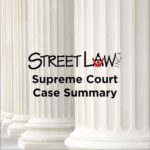One of our oldest human rights, habeas corpus safeguards individual freedom by preventing unlawful or arbitrary imprisonment. This documentary examines habeas corpus and the separation of powers in the aftermath of the 9/11 attacks as the Supreme Court tried to strike a balance between the president’s duty to protect the nation and the constitutional protection of civil liberties in four major Guantanamo Bay cases: Hamdi v. Rumsfeld, Rasul v. Bush, Hamdan v. Rumsfeld and Boumediene v. Bush.
Closed captions available in English and Spanish.
Civic Friendship: ‘I Am Rooting Hard for You’
“You will be our President when you read this note. I wish you well. I wish your family well. Your success now is our country’s success. I am rooting hard for you.”
It doesn’t sound like a note that a politician would write to the man who had just defeated him in a hotly contested election for the highest office in the nation just a few months prior, yet these are the exact words penned by President George H.W. Bush to his successor, newly inaugurated President Bill Clinton, on January 20, 1993. Many of the tributes to the former president recounted the story of this note as evidence of the character of the man, of his grace and humility. In this eLesson, students will explore the importance of character traits like humility and respect in the individuals who hold public office and how commitment to the rule of law has sustained the executive branch throughout the country’s history.
Rights at Risk in Wartime
The terrorist attacks on Sept. 11, 2001, stunned the nation. As commander-in-chief, President George W. Bush responded quickly but soon all three branches of government would be embroiled in the struggle to balance national security with the protection of individual liberties amid a war on terror. This lesson plan is based on the Annenberg Classroom video “Habeas Corpus: The Guantanamo Cases.” The four cases are examples of how the Supreme Court, the president and Congress fought to balance national security and civil liberties during the war on terror. At the heart of each case was the constitutional right of habeas corpus, the right to have one’s detention or imprisonment reviewed in court.
Boumediene v. Bush (2008)
Do detainees at Guantanamo Bay have the constitutional right to challenge the legality of their confinement using a writ of habeas corpus? This case summary shows how the Supreme Court answered that question in 2008.
Rasul v. Bush (2004)
Presidential Inaugurations, Past and Present
Every four years, on the steps of the U.S. Capitol building, the newly-elected President of the United States is inaugurated. This event not only includes the president taking the oath of office, but also provides the opportunity for the new President to lay out the direction he hopes to take the country. By analyzing historic texts and visuals, students can find common themes as well as important differences when comparing different inaugurations.
The Pursuit of Justice
The Pursuit of Justice book, written by Kermit L. Hall and John J. Patrick, analyzes 30 Supreme Court cases chosen by a group of Supreme Court justices and leading civics educators as the most important for American citizens to understand. An additional 100 significant cases included in state history and civics standards are summarized. The complete book or individuals chapters can be downloaded.
America at the End of the 20th Century, Part 1
James T. Patterson, historian at Brown University, discusses the end of the 20th century, focusing on the changes in the United States from Watergate to Bush v. Gore.
